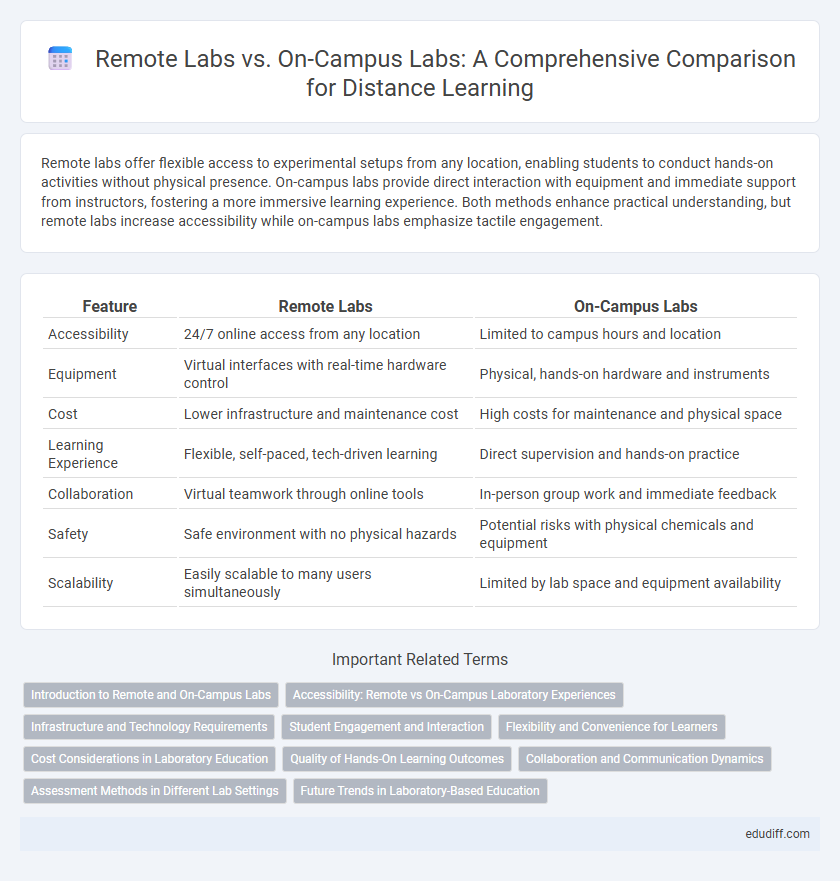Remote labs offer flexible access to experimental setups from any location, enabling students to conduct hands-on activities without physical presence. On-campus labs provide direct interaction with equipment and immediate support from instructors, fostering a more immersive learning experience. Both methods enhance practical understanding, but remote labs increase accessibility while on-campus labs emphasize tactile engagement.
Table of Comparison
| Feature | Remote Labs | On-Campus Labs |
|---|---|---|
| Accessibility | 24/7 online access from any location | Limited to campus hours and location |
| Equipment | Virtual interfaces with real-time hardware control | Physical, hands-on hardware and instruments |
| Cost | Lower infrastructure and maintenance cost | High costs for maintenance and physical space |
| Learning Experience | Flexible, self-paced, tech-driven learning | Direct supervision and hands-on practice |
| Collaboration | Virtual teamwork through online tools | In-person group work and immediate feedback |
| Safety | Safe environment with no physical hazards | Potential risks with physical chemicals and equipment |
| Scalability | Easily scalable to many users simultaneously | Limited by lab space and equipment availability |
Introduction to Remote and On-Campus Labs
Remote labs provide students with virtual access to scientific equipment and experiments via the internet, allowing for flexible learning without physical presence on campus. On-campus labs offer hands-on experience with direct supervision, fostering practical skills and immediate feedback in a controlled environment. Both lab types complement modern education models by balancing accessibility with experiential learning in STEM disciplines.
Accessibility: Remote vs On-Campus Laboratory Experiences
Remote labs offer unparalleled accessibility by allowing students to conduct experiments from any location with internet access, eliminating geographical and scheduling barriers common in on-campus labs. On-campus labs provide hands-on, tactile experiences but limit accessibility due to fixed locations, lab hours, and capacity constraints. The flexibility of remote labs supports diverse learning paces and inclusivity for students unable to attend in person, enhancing overall educational reach.
Infrastructure and Technology Requirements
Remote labs require advanced digital infrastructure, including high-speed internet, cloud computing platforms, and virtual simulation software to enable seamless access and real-time interaction from any location. On-campus labs rely heavily on physical equipment, dedicated space, and specialized hardware, necessitating substantial investment in laboratory facilities and maintenance. Technology requirements for remote labs emphasize software optimization, cybersecurity, and remote access protocols, while on-campus labs prioritize tangible resources and hands-on tools for experiential learning.
Student Engagement and Interaction
Remote labs leverage interactive simulations and real-time data sharing to enhance student engagement, promoting active participation despite physical distance. On-campus labs offer hands-on experiences and immediate peer collaboration, fostering spontaneous interaction and teamwork. Both formats require tailored strategies to maximize student involvement and effective communication within their environments.
Flexibility and Convenience for Learners
Remote labs provide unparalleled flexibility, allowing learners to access experiments and resources anytime from any location with internet connectivity, accommodating diverse schedules and learning paces. On-campus labs offer direct hands-on experience but require fixed attendance times and physical presence, limiting convenience for students with conflicting commitments. The flexibility of remote labs supports continuous learning and experimentation outside traditional classroom hours, which is a significant advantage for distance education programs.
Cost Considerations in Laboratory Education
Remote labs significantly reduce costs related to physical infrastructure, maintenance, and commuting expenses compared to on-campus labs. Investment in virtual platforms and high-quality simulation software can optimize budget allocation while providing scalable access to laboratory experiences. Institutions benefit from lower overhead and increased flexibility, making remote labs a cost-effective solution for laboratory education.
Quality of Hands-On Learning Outcomes
Remote labs utilize virtual simulations that can replicate complex experiments, offering flexible access to resources but often lack the tactile feedback essential for mastering fine motor skills. On-campus labs provide direct interaction with equipment and materials, enhancing sensory learning and critical thinking through real-time problem solving and immediate instructor guidance. Studies show that while remote labs improve conceptual understanding, on-campus labs lead to higher proficiency in hands-on tasks and practical skill retention.
Collaboration and Communication Dynamics
Remote labs leverage advanced digital communication tools to enable seamless collaboration among geographically dispersed students, fostering diverse teamwork and flexible interaction schedules. On-campus labs facilitate immediate, face-to-face communication that enhances spontaneous problem-solving and hands-on collaboration within physical learning spaces. Both environments cultivate distinct communication dynamics that impact team cohesion, with remote labs relying more on virtual coordination and on-campus labs benefiting from direct interpersonal engagement.
Assessment Methods in Different Lab Settings
Remote labs utilize online quizzes, virtual simulations, and automated data collection for continuous assessment, enabling real-time performance tracking. On-campus labs emphasize hands-on experiments evaluated through direct observation, practical tests, and lab reports, fostering immediate feedback and skill demonstration. Both settings integrate formative and summative assessments, but remote environments rely more on digital tools and asynchronous evaluation methods.
Future Trends in Laboratory-Based Education
Remote labs are increasingly integrating virtual reality and artificial intelligence to enhance immersive and interactive learning experiences, enabling students worldwide to access sophisticated laboratory equipment without geographical constraints. On-campus labs continue evolving by incorporating advanced simulation tools and hybrid models, blending hands-on experimentation with digital data analysis to prepare students for future technological demands. Emerging trends highlight a convergence of remote and on-campus methodologies, fostering flexible, scalable, and personalized laboratory education optimized for diverse learning environments.
Remote labs vs On-campus labs Infographic

 edudiff.com
edudiff.com